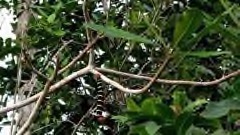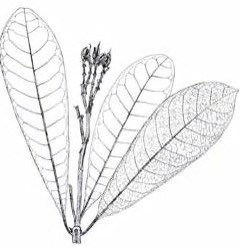 |
|
Alex Popovkin wikimedia |
 |
| http://www.edibleplants.org |
Translate this page:
Summary
Himatanthus sucuuba is an evergreen tree with a narrowly pyramidal crown and a straight, cylindrical bole of up to 40 cm in diameter. It grows about 8-16 m tall and can be found across South America where it is a known medicinal plant. It is used for pain and inflammation, cancerous tumors, ulcers, wounds, candida, tuberculosis, syphilis, etc. However, it is toxic in consumed in large doses. Latex can be obtained from the bark and stems. The wood is soft and not durable but easy to work. It is used for internal purposes, different kinds of boards for partition, boxes, tool handles, toys, etc.
Physical Characteristics

 Himatanthus sucuuba is an evergreen Tree growing to 12 m (39ft) by 10 m (32ft) at a medium rate.
Himatanthus sucuuba is an evergreen Tree growing to 12 m (39ft) by 10 m (32ft) at a medium rate.
See above for USDA hardiness. It is hardy to UK zone 10.
Suitable for: light (sandy) and medium (loamy) soils and prefers well-drained soil. Suitable pH: mildly acid, neutral and basic (mildly alkaline) soils. It cannot grow in the shade. It prefers dry or moist soil and can tolerate drought.
UK Hardiness Map
US Hardiness Map
Synonyms
Plumeria sucuuba Spruce ex M?ll.Arg.
Plant Habitats
Edible Uses
References More on Edible Uses
Medicinal Uses
Plants For A Future can not take any responsibility for any adverse effects from the use of plants. Always seek advice from a professional before using a plant medicinally.
Analgesic Anthelmintic Antiarthritic Antiasthmatic Antibacterial Antifungal Antiinflammatory Antirheumatic
Antitumor Aphrodisiac Astringent Blood purifier Cancer Emmenagogue Emollient
Febrifuge Laxative Purgative Skin Tonic Vermifuge Vulnerary
Himatanthus sucuuba is a well respected and widely used medicinal plant in herbal medicine systems in the Amazon and South America; many of its traditional uses have been explained and verified by research. It is mainly used for treating pain and inflammation related to many conditions; cancerous tumours, and as a broad spectrum antimicrobial for various internal and external infections[318 ]. Although toxic in larger doses, toxicity studies indicate that the use of the plant at traditional dosages is non-toxic. There have been no toxic, abortive, or birth defects reported[318 ]. The plant contains several medically active compounds. An antitumor iridoid compound and two depsides showing inhibitory activity of monoamine oxidase B (MAO-B) have been isolated from the bark[318 ]. In addition, two iridoid chemicals called plumericin and isoplumericin have been found in the bark and the latex. These two chemicals have been reported with cytotoxic, anticancer, antifungal and antibacterial actions in laboratory research[318 ]. An extract of the bark has been shown to provide significant protection from ulcers and to reduce gastric hypersecretion through several novel mechanisms of actions[318 ]. The latex has shown significant anti-inflammatory and pain relieving actions. The latex can exert anti-inflammatory effects even in the acute phase of the inflammatory process. This action has been attributed to the cinnamate chemicals that are found in the latex and bark. The bark has been shown to be significantly cytotoxic to five different human cancer cell lines, which may help explain why the tree has been used against cancer and tumours for many years in South America. This anti-cancerous action is probably related to the iridoids and triterpenoids in the tree bark[318 ]. Research has shown that the bark has a greater antifungal effect than a control drug (nistatin) that was used - this action has been attributed to the triterpenic esters found in the bark[318 ]. The plants effectiveness in treating infected wounds, candida, tuberculosis, syphilis, and even mange might be explained by the documented antimicrobial actions of the bark and latex[318 ]. The plant's use in the treatment of asthma might be explained by the smooth-muscle relaxant actions documented in 2005 by Brazilian researchers working with a bark extract[318 ]. The bark and the latex are considered analgesic, antiinflammatory, antirheumatic, antitumor, antifungal, anthelmintic, aphrodisiac, astringent, blood purifier, emmenagogue, emollient, febrifuge, laxative, purgative, tonic, vermifuge and vulnerary[318 , 739 ]. A decoction of the bark is taken internally in the treatment of rheumatism, stomach aches and body aches and pain. Applied externally, the powdered tree bark is sprinkled directly onto stubborn wounds and sores. The latex is placed in warm water which is used to bathe the part of the body suffering from arthritis, pain and/or inflammation[318 ]. The latex is also put directly onto abscesses, sores, wounds, rashes and skin ulcers. It is rubbed on to bot-fly bites in order to suffocate and kill the larvae under the skin (in both animals and humans)[318 , 739 ]. Both bark and latex are also used in the treatment of lymphatic gland diseases and inflammation; female disorders such as endometriosis, uterine fibroid tumours, menstrual irregularities and pain, ovarian cysts and ovarian inflammation; cancerous tumours and skin cancers; digestion problems such as indigestion, stomach aches, bowel inflammation and gastric ulcers; coughs, fevers, headaches, asthma and other lung disorders[318 , 739 ].
References More on Medicinal Uses
Now available: PLANTS FOR YOUR FOOD FOREST: 500 Plants for Temperate Food Forests and Permaculture Gardens.
An important new book from PFAF. It focuses on the attributes of plants suitable for food forests, what each can contribute to a food forest ecosystem, including carbon sequestration, and the kinds of foods they yield. The book suggests that community and small-scale food forests can provide a real alternative to intensive industrialised agriculture, and help to combat the many inter-related environmental crises that threaten the very future of life on Earth.
Read More
Other Uses
Charcoal Fuel Latex Wood
Other Uses: A latex is obtained from wounds in the bark and stems[420 ]. Although toxic, it is used medicinally in small quantities[420 ]. The wood is medium-textured, moderately heavy, soft, with poor mechanical properties and not very durable. Easy to work with, it is used for various internal purposes including scantlings, beams, laths and various kinds of boards for partitions; it is also used for making boxes, tool handles and toys[420 ]. The wood is used for fuel and to make charcoal[420 ].
Special Uses
References More on Other Uses
Cultivation details
Grows best in a sunny position[420 ]. Requires a well-drained soil[420 ]. Grows best in a deep, sandy to loamy soil[420 ]. Established plants are drought tolerant[420 ]. Young plants have a moderate rate of growth[420 ]. The plant can flower all year round[420 ].
References Carbon Farming Information and Carbon Sequestration Information
Temperature Converter
Type a value in the Celsius field to convert the value to Fahrenheit:
Fahrenheit:
The PFAF Bookshop
Plants For A Future have a number of books available in paperback and digital form. Book titles include Edible Plants, Edible Perennials, Edible Trees,Edible Shrubs, Woodland Gardening, and Temperate Food Forest Plants. Our new book is Food Forest Plants For Hotter Conditions (Tropical and Sub-Tropical).
Shop Now
Plant Propagation
Seed - best sown as soon as it is ripe in a sunny position in a nursery seedbed. When the seedlings are 4 - 6cm tall, pot them up into individual containers[420 ].
Other Names
If available other names are mentioned here
Plumeria sucuuba, apach, bellaco kaspi.
Native Plant Search
Search over 900 plants ideal for food forests and permaculture gardens. Filter to search native plants to your area. The plants selected are the plants in our book 'Plants For Your Food Forest: 500 Plants for Temperate Food Forests and Permaculture Gardens, as well as plants chosen for our forthcoming related books for Tropical/Hot Wet Climates and Mediterranean/Hot Dry Climates. Native Plant Search
Found In
Countries where the plant has been found are listed here if the information is available
Weed Potential
Right plant wrong place. We are currently updating this section.
Please note that a plant may be invasive in one area but may not in your area so it’s worth checking.
Conservation Status
IUCN Red List of Threatened Plants Status : This taxon has not yet been assessed

Growth: S = slow M = medium F = fast. Soil: L = light (sandy) M = medium H = heavy (clay). pH: A = acid N = neutral B = basic (alkaline). Shade: F = full shade S = semi-shade N = no shade. Moisture: D = dry M = Moist We = wet Wa = water.

Expert comment
Author
(Spruce ex Mull.Arg.) Woodson
Botanical References
1
Links / References
For a list of references used on this page please go here
A special thanks to Ken Fern for some of the information used on this page.
Readers comment
| Add a comment |
|
If you have important information about this plant that may help other users please add a comment or link below. Only comments or links that are felt to be directly relevant to a plant will be included. If you think a comment/link or information contained on this page is inaccurate or misleading we would welcome your feedback at [email protected]. If you have questions about a plant please use the Forum on this website as we do not have the resources to answer questions ourselves.
* Please note: the comments by website users are not necessarily those held by PFAF and may give misleading or inaccurate information.
To leave a comment please Register or login here All comments need to be approved so will not appear immediately.
|
Subject : Himatanthus sucuuba
|
|
|
|